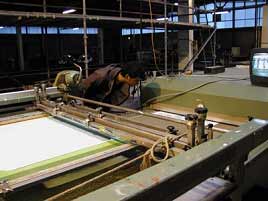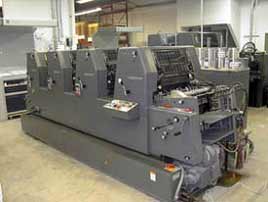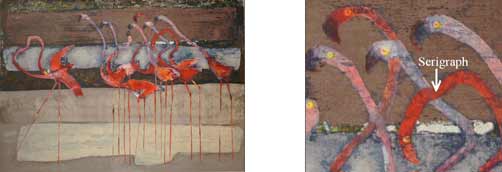|
Edwin Salomon’s printing techniques
SERIGRAPH (SILK SCREEN) PRINTING
 This printing technology involves the use of stencils to transfer Edwin Salomon original art design. Paint is applied to a silk screen and penetrates areas of the screen not blocked by the stencil. This printing technology involves the use of stencils to transfer Edwin Salomon original art design. Paint is applied to a silk screen and penetrates areas of the screen not blocked by the stencil.  By using several silk screens a number of colors are applied to a single print. Edwin Salomon uses separate screens for each individual color, using more than 30 silk screens per print. Each silk stencil is modified and carefully improved by hand, by the artist; each color is then printed, one color set a time, onto paper. The process does allow for the depositing of heavier amounts of color and does allow for some texture. Color fidelity is generally very good. However, the silk screen dots inherent in serigraphs have a tendency to break up fine detail compared to the other Lithography printing technology. By using several silk screens a number of colors are applied to a single print. Edwin Salomon uses separate screens for each individual color, using more than 30 silk screens per print. Each silk stencil is modified and carefully improved by hand, by the artist; each color is then printed, one color set a time, onto paper. The process does allow for the depositing of heavier amounts of color and does allow for some texture. Color fidelity is generally very good. However, the silk screen dots inherent in serigraphs have a tendency to break up fine detail compared to the other Lithography printing technology.
 Each print is then numbered uniquely & sequentially out of the total edition & signed by the artist using a pencil. Each print is then numbered uniquely & sequentially out of the total edition & signed by the artist using a pencil.
CONTINUOUS-TONE LITHOGRAPHY
This printing technique is based on a modification of the lithographic press featuring a rubber-covered cylinder between the printing cylinder and the impression cylinder. The plate cylinder transfers the image to the rubber blanket cylinder, which in turn offsets it onto the paper carried by the impression cylinder. Continuous-tone lithography is a reproduction process with many of the characteristics of original stone lithography. There are no halftone or screen dots that break up fine detail and lower the perceived value of the print. The color gradient change can be very precise. Accordingly, color separations are made by hand to achieve the highest possible quality.
 Each print is then numbered uniquely & sequentially out of the total edition & signed by the artist using a pencil. Each print is then numbered uniquely & sequentially out of the total edition & signed by the artist using a pencil.
Commercially there is no difference in value between these two printing technologies, but some people would like to know & distinguish between them.
How to distinguish between one technology and another?
1. Tilt the painting horizontally in front of a strong light until you can hardly see details. If all the surface seems to be with the same color texture than it is a Lithograph, otherwise if there is a color difference, as can be seen in this picture below, then it is a serigraph (silk screen).

2. If the print has any texture, then it is a serigraph.
3. Solid and deep color can be achieved only with serigraph.
4. Lithograph produces much smoother & more detailed color gradient & color variations.
5. There are prints produced with a combined technology (Serigraph & Lithograph), as can be seen with the Flamingos print. The pink necks are made by serigraph technology, while all the rest is Lithograph.

| 